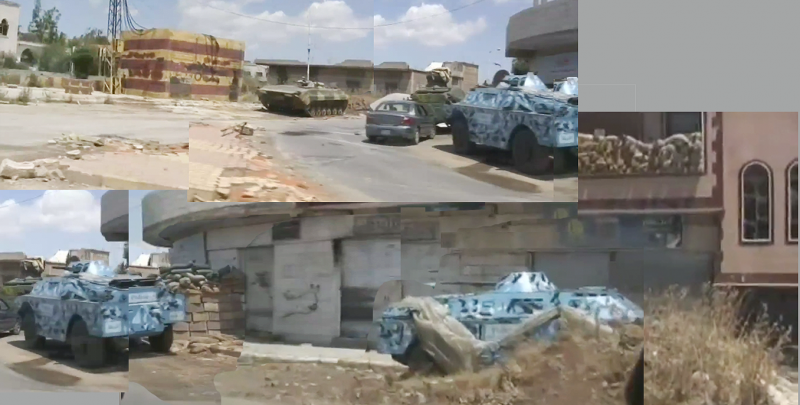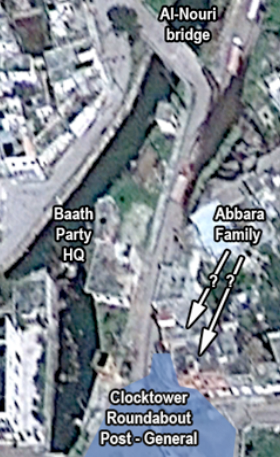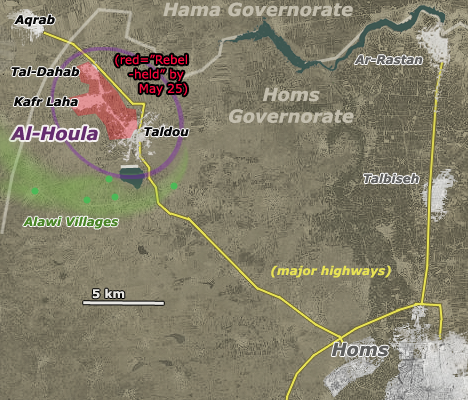 Aqrab is a mid-sized town of - originally - about 11,000 people. It lies just about 2 km north of the Houla region, and even called a part of Houla in some readings, despite being across the border in Hama province.
Aqrab is a mid-sized town of - originally - about 11,000 people. It lies just about 2 km north of the Houla region, and even called a part of Houla in some readings, despite being across the border in Hama province.The direct Houla Massacre-Aqrab connection is of two parts: fighters from there swooping south to help, and victims from there dying either with the Abdulrazaq familiess in Taldou, in Aqrab, or both.
The indirect connections also are fascinating, with a massacre in each locale about six months apart, each with its own telling patterns covered below. First, the two connections to events of May 25, 2012:
Fighters From:
"Houla" Sunni solidarity rebels from Aqrab reportedly took part in the May 25 battle. The ANNA News witnesses reported:
At 7:00 pm, Al-Farouq brigade, led by Abdulrazak Tlass, of the so-called “Free Syrian Army” arrived. He had more than 250 armed men with him from the city of Rastan, he also had 2 other groups with him one from Al-Qabo village, led by Yehya Al-Yusef, and another from Falla village.These towns sounds like Al-Qabo and Fullah/Fallah - the two main Alawite villages the Shabiha were said to come from. Why are Sunni rebel fighters coming from there too? Apparently not, and this is an especially odd/ironic mix-up. The better telling seems this seems to be based on:
The town was attacked from the north-east by groups of bandits and mercenaries, numbering up to 700 people. The militants came from Ar-Rastan (the Brigade of al-Farouk from the Free Syrian Army led by the terrorist Abdul Razak Tlass and numbering 250), from the village of Akraba (led by the terrorist Yahya Al-Yousef), from the village Farlaha , joined by local gangsters, and from Al Hula.I conclude Qabo = Akraba/Aqrab, and Falla = Farlaha = Kafr Laha, the biggest town of Houla just north of Taldou. Al Hula = elsewhere in, maybe Taldou itself.
Possible verification for the presence of a Yousef family contingent comes from a May 25 victim listed by only the VDC - Saeed Mohammad Munib Al-Yousef "martyr" # 17034. The entry number shows he was reported earlier than most victims, who number well above the 1700s. All the other rebel fighters are listed in this early portion. Age 32 and hailing from Houla (again, sometimes considered to include Aqrab), it says he was a civilian who died in shelling.
Civilian doesn't mean much in this context; another one killed by "shelling" that day was Talal Bakour, # 17017 who the same source notes was the "brother of defected major Nidal Bakour," an alleged leader of one unit involved directly in the massacres. How did his brother get shot if not by fighting or helping alongside his brother? He was dressed in sporty clothes, prepared for physical movement, like the fighters we see on video. The same may go for Saeed al-Yousef, image-free as far as we know. He was likely tagging along with his brother Yehya as they both helped pave the way for the massacres of May 25.
Victims From:
The 2014 list of victims says, as prior sources did, that the whole Fadi Mahmoud Al-Kurdi family "came from Aqrab village." Fadi's wife was an Abdulrazaq - un-listed, unnamed, implicitly a survivor, and by some details likely to be - allegedly - a shot survivor blaming Shabiha and calling herself "Rasha Abdulrazaq." That part is unclear, and the father Fadi also didn't die, by not being in the frame to begin with - off on business or what is unclear. Just the 3 sons and/or 2 of them and, the new list says, a daughter Zeynab Fadi Adulrazaq, age 9. Or, the provided photos might say, all 3 plus the girl. (to be considered better...)
But that wasn't all - these 3-4 kids also had their paternal grandparents fall to assassins that day. Fadi's father, Mahmoud, and his wife Zainab Arouq, both from Aqrab but implicitly - by being listed as Houla Massacre victims - killed in Taldou, in the zone of "Shabiha" invasion. Zainab - the granddaughter's namesake - isn't listed in the 2014 roster unless it's by that reincarnation, but her husband is, with this odd note:
91- Mahmoud Omer Al-kurdi, 45 years old, father, he was resident of Aqrab village and lived in place where massacred happened. (emphasis mine)
The straight reading of that is that he was killed in a part of the "Houla Massacre" that happened in Aqrab where he lived. Nothing else rules that out, nor directly supports it.
Well, Akrama Bakour counters it, saying the "shepherd" al-Kurdi was killed at the entrance to the Abdulrazaq alley on Saad Street. But he seems to place the children both with him and inside Samir Abdulrazaq's house - maybe they were all visiting and he was the last to arrive, caught as he pulled up and killed first. His wife isn't mentioned there. Why this one victim out of all would be jut outside the area is unclear, when he and his wife are also the most likely to have been killed all the way outside of Al-Houla proper. That might be his coded way of explaining how they too came to die by the Shabiha who, we hear, walked to and from Fullah 1.5 km away. He just shifted Mustafa way south to that alley, but not into some house of his own there.
Further, the alleged movement of fighters from there to Taldou means either place is entirely reachable to that force likely in either location. They could hit at least the granparents in Aqrab early on, or just take them captive to kill with the others, before setting out to Taldou at mid-day. Whereas those alleged idiot thugs from Fullah would face a ten km march each way to and from Aqrab. Therefore, Bakour's story that they all happened to be visiting the Abdulrazaq in-laws that day.
Indirect Links: Massacre to Massacre
(modified from the report, pages 51-52)
Just after the Houla Massacre, when allegations of Shia or Alawi victims were widespread, opposition people countered with a blanket claim that anyone killed in Houla was by default a Sunni. That's all that lived in any of its three towns or implicitly in the whole area.
But Aqrab, often considered part of Al-Houla, was then, before, and for another six months, a Sunni majority city with a western Alawite district of about 2,000 people. The world learned faintly about this – and the CIWCL learned much more - after an early December, 2012, attack by rebels from Houla, Aqrab, and Rastan who took over the western district and emptied it. Reports say most inhabitants fed in time, but about 500 civilians were taken hostage. Including children and women, these were mostly of an extended Jubeili family, and perhaps some Melhems, among others. About half of these were freed in exchanges with the government over the following week, with rebels saying nothing to the world.
They only broke the news of an Aqrab Massacre on December 11 - about 200 Alawites in a house were blown up by their “Shabiha” captors, they said, with help from the Syrian army and air force. That story fell apart spectacularly, thanks to an unexpected, spot-on report by Channel 4's Alex Thomson showing that house still standing unscathed the next day. But the fate of the fnal 200-230 or so smoked-out Alawite civilians has never been settled. See the ACLOS page on Aqrab Massacre. I made sure Alex Thomson saw it, and he says it "seems to bear out what I reported from Aqrab at the time."
Either way, after this, opposition sources could say Aqrab was 100% Sunni, the way they said al-Houla was - right after the May massacre. I would caution against reading too much – or too little – into that parallel.
The Aqrab connection increases the possibility of Alawite massacre victims. But with nothing else but an erred suggestion of that (see Houla Massacre Myths) and that they married into a family of alleged Shia converts, we should presume the Kurdis' religious status as simply unknown.
For effect, the rudimentary map we came up with for the few locations we could place in Aqrab - explained here.







